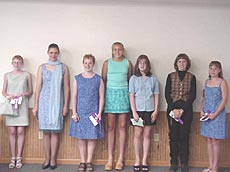|
A
field day sponsored recently by the Logan County Soil and Water
Conservation District and the Land of Lincoln Soil Savers gave area
farmers a look at a new stream stabilization technique, one way to
control soil erosion. These two groups, along with the U.S.
Department of Agriculture Natural Resources Conservation Service and
the Illinois Department of Agriculture are working on projects to
prevent Logan County’s waterways from carrying away its farmland.
"With
three good-sized creeks in the county —
Salt, Kickapoo and Sugar Creeks —
it’s a never-ending job," Dickerson says. As
a district conservationist for the NRCS, Dickerson works closely
with Logan County’s Soil and Water Conservation District.
On
Thursday he took a group of area farmers to a Kickapoo Creek site
southeast of Atlanta, on farm ground owned by Dave Evans and Dan
Koons, to explain a new technique called the stream barb system.

[These
three rock projections are a new stream stabilization technique
called barbs. Pointing
upstream, they work together to redirect the water in Kickapoo Creek
toward the middle of the creek and keep it from undercutting the
stream bank.]
What
the farmers saw were three projections of large stone riprap jutting
out into the creek, angling upstream, at a point where the creek had
been cutting away the bank. The barb-shaped stone projections work
together to catch the current and redirect it to the middle of the
stream, away from the bank which is being eroded.
The
project was completed in December of last year, and, according to
the landowners, is working just as predicted.
"A
few weeks ago, when the water was higher, I could see it working. I
could actually see water turn and go back into the channel,"
Koons said.
Before
the barbs were put in, he added, the bank went straight down,
because it was being undercut by the creek at the rate of at least a
foot a year. Now the stream bank slopes, maintaining the angle it
was given by the construction crew that put in the new stabilization
system. The bank is also being held in place by the natural
vegetation that is beginning to grow there.
The
new stream barb system is protecting about 600 feet of the bank of
Kickapoo Creek, Dickerson says, preventing the loss of about
one-half ton of soil per foot per year. That means 300 tons of prime
topsoil is no longer washing down the creek, eventually ending up
somewhere in the Gulf of Mexico.

It is
the nature of streams and rivers to meander, traveling in a series
of S-curves, as they slow down and broaden out their flood plains,
Dickerson explains. Formerly, engineers tried to keep streams from
eroding the land around them by straightening them out, a process
called channelizing. Kickapoo Creek was channelized on the Koons-Evans
farm in the mid-1970s, when the land belonged to a different owner.
But
the channelizing couldn’t prevent the creek from reverting to its
natural tendency to meander, and it soon began cutting into the land
again. (It’s now against federal law to straighten a stream.)
Today
the idea is to work with nature, allowing the stream to meander but
preventing it from meandering too much, Dickerson explains.
"Moving water is one of the strongest forces on earth. We are
now going with the natural force of the stream, rather than fighting
it."
[to top of second column in
this article]
|

Although
it’s the newest technique, the stream barb system on the Koons-Evans
farm isn’t the only system on Kickapoo Creek that is keeping Logan
County soil in Logan County. Two different projects upstream, called
bendway weirs and similar to the barb system, are on land owned by
Rodney Alberts and Jerry Cisco. They were also installed with the
help of Dickerson and the Soil and Water Conservation District.
These
stream stabilization systems not only save soil, they also
contribute to better water quality. They prevent streams from
filling up with sediment and also prevent agricultural chemicals and
nutrients from draining into waterways. Dickerson says the weirs and
barbs are also good for wildlife. A degrading stream is sterile,
providing little or no natural habitat. Rock bars, however, make
good aquatic habitats, places for fish to hide or breed.
Dickerson
explained the process of constructing the stream barb system to the
group of about 30 farmers who came to the site, pointing out that
the average cost of installing such a system on a Logan County farm
would be about $11,000. However, the Illinois Department of
Agriculture has a $1 million program in place this fiscal year (July
1, 2001 to June 30, 2002) to help fund stream stabilization, and
farmers who put in an approved system can get as much as 75 percent
of the cost reimbursed.

Several
construction firms in the area do the work, Dickerson said, and the
NRCS is ready to help farmers do the paperwork. A steam
stabilization project usually takes about a year from start to
finish because of the permits required -- from the U.S. Army Corps
of Engineers, the Illinois Environmental Protection Agency and the
Illinois Department of Natural Resources.
The
NRCS has been doing stream stabilization projects for the past 10
years, along with a number of other conservation programs. These
include no-till farming, which according to Dickerson has
contributed more to soil erosion control than any other program, and
the Conservation Reserve Program, the USDA’s most popular
conservation program. CRP allows landowners to take cropland out of
production for as much as 15 years, getting payments of as high as
$192 an acre for the idle land. The land can be put in grass for
erosion control or planted with trees. Most land in CRP is already
environmentally sensitive, Dickerson says, often located on a flood
plain or on sloping ground.
After
viewing the stream barb system, the farmers adjourned to the Atlanta
Park shelter, where they heard a program by Howard Brown, agronomist
with Growmark of Bloomington. Brown walks the fields, looks at crops
for indications of insects, fungus and other plant diseases, and
gives farmers an update on how the season is progressing and what to
look for when making decisions for next year’s planting.
Brown
said the yield potential for area crops this year looks good
"if the weather is good from here on out."
Anyone interested in more
information about stream stabilization or other conservation
practices may call the Soil and Water Conservation District office
at (217) 732-2010, Ext. 3.
[Joan
Crabb]

|
|
Foods
Delegates
Chris
Ackerman, Lincoln; Food Preservation
Emily
Bakken, Lincoln; Dairy Foods, Breads and Cereals, and International
Foods
Elizabeth
Carter, Lincoln; Food Preservation
Abby
Coers, Chestnut; Fruits & Vegetables
Natalie
Coers, Emden; International Foods, and Breads and Cereals

[Foods delegates chosen to represent Logan County 4-H
at the Illinois State Fair are (back row, L to R) Elizabeth Carter,
Chris Ackerman, Jennifer Schahl, Krista Ubbenga, Angela Cunningham
and Natalie Coers; (front row, L to R) Jill Patrick, Jenna Opperman,
Kim Turner, Emily Bakken and Abby Sasse. Not pictured: Laura Schahl
and Abby Coers.]
Angela
Cunningham, Elkhart; Breads and Cereals
Jenna
Opperman, Lincoln; You Learn to Bake
Jill
Patrick, New Holland; Sports Nutrition, Food Demonstration
Abrigail
Sasse, Beason; Breads and Cereals, Fruits and Vegetables, and
International Foods
Jennifer
Schahl, Lincoln; International Foods
Laura
Schahl; Lincoln, Let’s Start Cooking
Kim
Turner, Atlanta; International Foods
Krista
Ubbenga, Hartsburg; Breads and Cereals, Food Preservation, and
Fruits and Vegetables
Alternates
Benjamin
Buse, Beason; Exploring Food Heritage
Elizabeth
Carter, Lincoln; Exploring Food Heritage
Susan
Cochran, Mount Pulaski; Fruits and Vegetables
Jonathon
Davis, New Holland; Tricks for Treats I
Amanda
Davison, Beason; Dairy Foods
Holly
Ingram, Lincoln; Fruits and Vegetables
Allicent
Pech, Lincoln; Sports Nutrition

[Foods
category alternates chosen are (L to R) Holly Ingram, Allicent Pech,
Elizabeth Carter, Amanda Davison and Susan Cochran.
Not pictured: Jonathon
Davis and Benjamin Buse.]
Top
Foods 4-H’ers in Logan County
The
following 4-H’ers were chosen as top individuals in Foods. These
4-H’ers will compete for an overall county award which will be
presented at the 4-H Achievement Night in November.
Chris
Ackerman, Lincoln; Food Preservation
Emily
Bakken, Lincoln; Dairy Foods, Breads and Cereals, and International
Foods
Elizabeth
Carter, Lincoln; Food Preservation
Abby
Coers, Chestnut; Fruits and Vegetables
Natalie
Coers, Emden; International Foods, and Breads and Cereals
Angela
Cunningham, Elkhart; Breads and Cereals
Jenna
Opperman, Lincoln; You Learn to Bake
Jill
Patrick, New Holland; Sports Nutrition, and Food Demonstration
Abrigail
Sasse, Beason; Breads and Cereals, Fruits and Vegetables, and
International Foods
Jennifer
Schahl, Lincoln; International Foods
Laura
Schahl, Lincoln; Let’s Start Cooking
Kim
Turner, Atlanta; International Foods
Krista
Ubbenga, Hartsburg; Breads and Cereals, Food Preservation, and
Fruits and Vegetables
Click
here for complete results of the 4-H Food and Nutrition Show.
[to top of second column in
this article]
|
Home
and Family Show
At
the Home and Family Show, a number of 4-H’ers were chosen as award
winners and to go on to the Illinois State Fair. These individuals
are listed below.
Bethany
Furman, Waynesville — Sewing and Textiles I Construction Award
Allicent
Pech, Lincoln — Sewing and Textiles II Construction Award
Krista
Ubbenga, Hartsburg — Sewing and Textiles III Construction Award
Leila
Ballinger, Atlanta — 4-H Fashion Revue Award
Nichole
Benz, Lincoln — Special Sewing and Textiles Award
Colleen
Pech, Lincoln — Special Sewing and Textiles Award
Sewing and Textiles
Delegates
Leila
Ballinger, Sewing and Textiles III
Bethany
Furman, Sewing and Textiles I
Leanna
Gleason, Sewing and Textiles II
Allicent
Pech, Sewing and Textiles II
Abrigail
Sasse, Sewing and Textiles III
Krista
Ubbenga, Sewing and Textiles III
Marjorie
White, Sewing and Textiles II

[Clothing and Textiles delegates are (L to R)
Allicent Pech, Leila Ballinger, Bethany Furman, Krista Ubbenga,
Marjorie White, Abby Sasse and Leanna Gleason.]
Alternates
Emily
Bakken, Sewing and Textiles III
Katelyn
Beavers, Sewing and Textiles II
Abby
Coers, Sewing and Textiles II
Amanda
Davison, Sewing and Textiles III
Rachael
Jones, Sewing and Textiles I
Kim
Turner, Sewing and Textiles II

[Clothing and Textiles alternates are (L to R) Amanda
Davison, Rachael Jones, Katelyn Beavers, Emily Bakken, Kim Turner
and Abby Coers.]
Fashion Revue
Delegates
Emily
Bakken, Lincoln
Leila
Ballinger, Atlanta
Katelyn
Beavers, Broadwell
Krista
Ubbenga, Hartsburg
Alternates
Leanna
Gleason, Elkhart
Allicent
Pech, Lincoln
Marjorie
White, Beason
Interior Design
Delegates
Bethany
Furman, Waynesville; Beginning
Sarah
Moore, Elkhart, Beginning
Jenna
Opperman, Lincoln; Beginning

[Interior Design delegates are (L to R) Bethany
Furman, Sarah Moore and Jenna Opperman.]
Child Care
Delegates
Mary
Healy, Middletown; Child Development III
Michelle
Johnson, Latham; Child Development II
Krista
Ubbenga, Hartsburg, Child Development II

[Child Development delegates are (L to R) Mary Healy
and Krista Ubbenga. Not pictured: Michelle Johnson.]
Click
here for complete results of the Logan County 4-H Home and Family
Show.
|